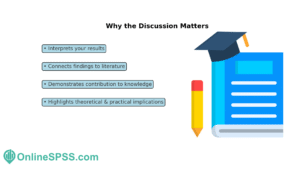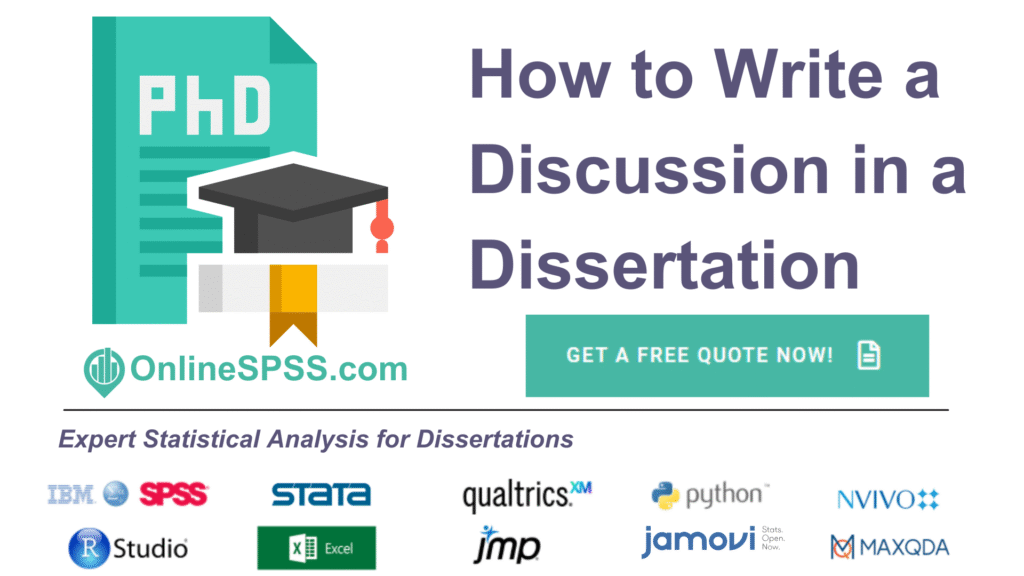How to Write a Discussion in a Dissertation: A Complete Guide
The discussion chapter is often described as the intellectual heart of a dissertation. While the results chapter presents findings in a neutral way, the discussion is where you analyse, interpret, and explain what those findings mean in relation to your research questions, the literature, and theoretical frameworks. It is also where you highlight the contribution of your study, its limitations, and the implications for future research or practice.
Writing this chapter requires critical thinking, strong organisation, and academic maturity. This guide explains in detail how to approach the discussion section, what elements to include, and how to avoid common mistakes.
Discover our complete dissertation guide series: [Abstract], [Introduction], [Literature Review], [Methodology], [Results], [Conclusion], [Discussion], [References], and [Appendix].

Purpose of the Discussion Chapter
The main goal of the discussion is to move from description to interpretation. Instead of restating results, you answer the questions:
- Why did I obtain these findings?
- How do they fit with previous research?
- What do they mean for theory, practice, or policy?
Interpretation of Results – explaining what your findings mean and why they matter.
Contextualisation – linking results to the literature and theoretical frameworks introduced earlier.
Contribution – showing how your study advances academic knowledge or has practical relevance.
By doing so, you demonstrate that your work has value beyond data collection and that you can engage with your subject critically.

Structuring the Discussion
A strong discussion usually follows a funnel-shaped structure, starting broad and gradually narrowing down to specific implications. A recommended structure is:
- Introduction to the discussion – briefly remind readers of your research aims and summarise the main findings.
- Interpretation of findings – explain what the results mean and why they are important.
- Comparison with literature – link your findings with past studies, showing similarities, differences, or new insights.
- Theoretical implications – discuss how your results support, challenge, or extend existing theories.
- Practical implications – highlight applications in real-world contexts such as education, healthcare, or business.
- Limitations – acknowledge weaknesses without undermining your work.
- Recommendations for future research – suggest directions that other scholars can pursue.
- Closing summary – end with a concise statement about the contribution of your study.

How to Interpret Findings Effectively
Interpretation means explaining patterns and making sense of the data. For quantitative research, focus on effect sizes, strengths of relationships, and unexpected outcomes. For qualitative research, interpret themes and subthemes, connecting them to broader social or cultural contexts.
Example:
“The finding that female students reported lower stress levels than males may be explained by gender differences in coping strategies, a factor also highlighted in Brown (2019). This suggests that wellbeing interventions may need to be gender-sensitive.”
Here, the student does more than repeat a result; they explore possible reasons and link to literature.
Linking Back to Literature and Theory
The discussion should never exist in isolation. A strong approach is to revisit your literature review and show how your research fits into existing debates. Use phrases such as:
- “This finding supports…”
- “In contrast to…”
- “Extending the work of…”
For example:
“Our results extend the self-determination theory (Deci & Ryan, 1985) by showing that autonomy-supportive teaching benefits not only motivation but also long-term academic achievement.”
This demonstrates that your study is a meaningful contribution to the academic conversation.
How to Provide Interpretation Without Repetition?
The key is to move beyond what was found to why it matters. Avoid simply repeating statistical values or thematic labels. Instead, explain the underlying meaning.
For quantitative studies:
Discuss the strength of relationships or effect sizes.
Explain why a hypothesis was supported or rejected.
For qualitative studies:
Interpret what themes reveal about participant experiences.
Consider cultural, social, or contextual explanations.
By focusing on meaning, you avoid redundancy with the results chapter.

The Importance of Addressing Limitations
Students often fear that mentioning limitations weakens their dissertation, but the opposite is true. Discussing limitations shows that you can evaluate your research critically. Common limitations include:
- Sample size and generalisability.
- Constraints in data collection methods.
- Possible biases or confounding variables.
When addressing limitations, always balance them with strengths. For instance:
“Although the sample size was relatively small, it provided in-depth qualitative insights that cannot be captured in large-scale surveys.”
Writing the Implications of Your Study
Implications highlight why your research matters. These should be divided into:
- Theoretical implications: contributions to academic models or frameworks.
- Practical implications: recommendations for practitioners, organisations, or policymakers.
- Future research implications: new directions that other scholars can explore.
Example:
“The findings suggest that remote learning platforms should incorporate peer-support features to reduce feelings of isolation among students.”
Avoiding Common Mistakes in Discussion Writing
- Repeating results instead of explaining them.
- Overstating findings beyond what data supports.
- Ignoring contradictory evidence because it complicates the narrative.
- Blurring boundaries between discussion and conclusion.
- Writing too generally without linking back to research questions.
By avoiding these pitfalls, your discussion remains focused and credible.

Length and Style of the Discussion
The length of the discussion depends on the size of your dissertation. For a Master’s dissertation, expect between 2,500–4,000 words. For a PhD, this section may exceed 8,000 words.
In terms of style:
- Use an academic but accessible tone.
- Write clearly and logically.
- Use cautious language when interpreting results (“may suggest,” “could indicate”).
Final Checklist for Writing the Discussion
- Have you summarised the main findings at the start?
- Did you interpret and not just repeat results?
- Have you connected findings to literature and theory?
- Are implications clearly discussed?
- Have you addressed limitations fairly?
- Is your writing objective and evidence-based?








